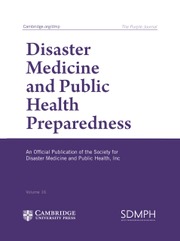To the Editor
The objective of the recent Disaster Medicine and Public Health Preparedness publication “Spontaneous and unplanned mass gathering events: A scoping review of health considerations for riots, civil unrest, and protest” by Ranse et al.Reference Ranse, Gray, Mortelmans, Sultana, Achour and Barten 1 is to obtain data to improve planning for spontaneous mass gathering events (SGME) as “unplanned assemblies of a significant number of people, often arising in response to specific triggers or circumstances.” They write that “Unlike organized mass gathering events (MGEs), SMGEs are characterized by their rapid formation and lack of formal pre-planning.” Thus, the key difference between a planned or unplanned gathering is the availability of on-site medical assets that have coordinated with local pre-hospital emergency medical services (EMS). The acceptance of this definition would have enabled a broader search with expanded keywords and search terms.
For instance, a music festival with hundreds of attendees with MGE on-site medical response capabilities will likely have improved post-incident clinical outcomes with coordinated pre-hospital and hospital care. A piazza with screens to watch a Union of European Football Associations (UEFA) Champions League final on June 3, 2017, in essence a sports festival, that did not include MGE on-site response capabilities, should be considered a SMGE due to the lack of these resources. At least 1,672 people were injured, including seven who were seriously injured and three died. 2 , 3 The medical subject headings (MeSH) terms “special events” and “mass gatherings,” and keywords “sport” and “stampede” should have captured this SMGE, yet this was not included as one of the publications found by the study and therefore data was not obtained.
The authors noted that a limitation of their study was due to the lack of review of gray literature, typically government agency after-action and investigation reports or credible media reportsReference Feliciani, Corbetta, Haghani and Nishinari 4 that are not captured in the peer-review medical literature search using the Preferred Reporting Items for Systematic Reviews and Meta-Analyses Extension for Scoping Reviews (PRISMA-ScR) methodology.Reference Paez 5 The validity of such sources can be questioned but due diligence by the authors that utilize gray literature can determine accuracy to improve the compendium of data to then undergo analysis in addition to the data obtained through the PRISMA-ScR search of peer-reviewed medical literature. The above UEFA watch-party disaster is available through a gray literature search of credible media reports limited by the criminal investigation.
Conclusion
Local authorities know that a crowd is accumulating with the potential for a SMGE. Data not captured could have added to information that authorities could incorporate into the creation of their SGME standard operation procedures (SOPs). Local authorities that are aware of a MGE that is not required by the insurance carrier or local regulation to have on-site medical response assets could then consider this event an SMGE to prepare pre-hospital EMS and hospitals for potential casualties. The data from this PRISMA-ScR has potential for local authorities to begin the creation of their SGME SOPs. Future PRISMA-ScR studies have the opportunity to use expanded keywords and search terms and include gray literature to add to this creative process.
Author contribution
ESW: conception, writing first draft, revision; JK: review and revision; and ML: review and revision, supervision.
Competing interests
The authors have no competing interests.

